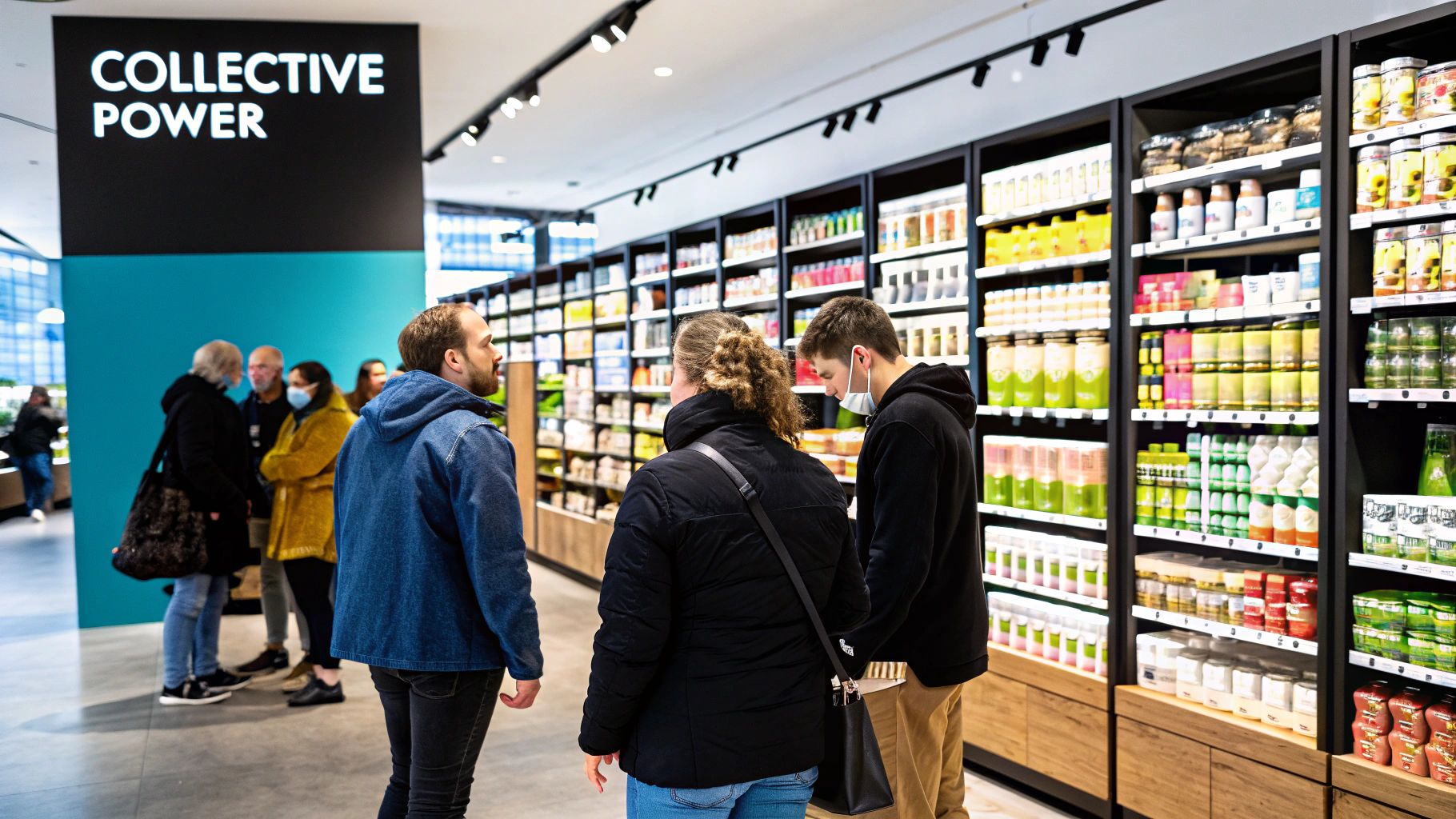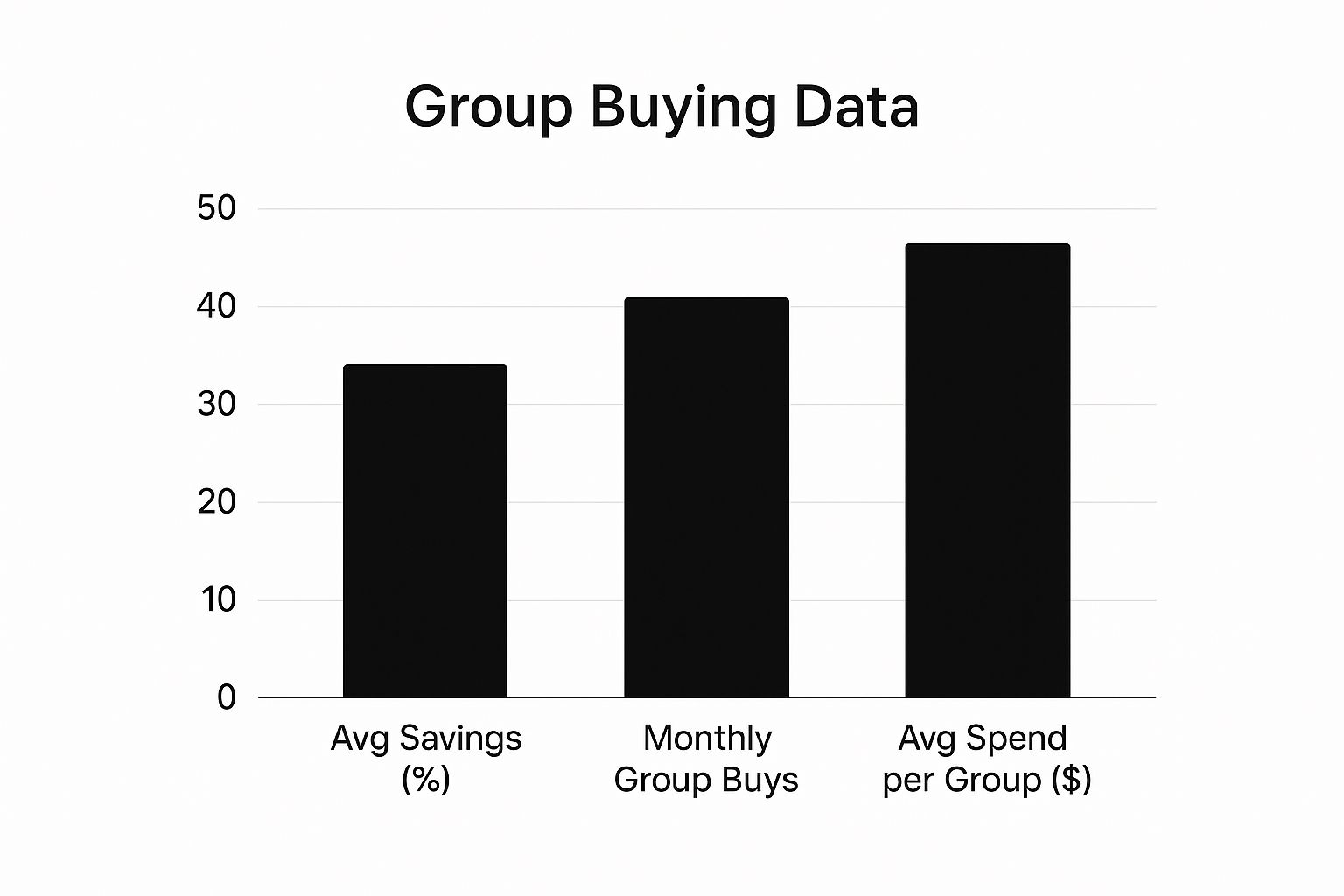
Boost Your Business with Collective Buying Power Strategies
Share
Understanding How Collective Buying Power Really Works

Collective buying power is the advantage consumers get when they join forces to purchase goods or services. This combined approach gives them stronger negotiating power for better prices and terms than they could achieve on their own. It's similar to a wholesale discount, but available to everyday shoppers. This amplified influence is changing how businesses interact with their customers.
The Mechanics of Collective Bargaining
The basic principle is straightforward: larger quantity equals increased leverage. Businesses are more likely to offer discounts when a large group commits to buying a product or service. This is because securing a bulk order, even with a slightly smaller profit margin per item, can lead to higher overall profits. Plus, it guarantees a certain sales volume, minimizing risk and potentially reducing marketing expenses.
The Digital Revolution in Group Purchasing
The internet and social media have made collective buying more accessible, enabling people to connect and organize regardless of location. Platforms like AccountShare facilitate this by providing the necessary infrastructure for secure and efficient group purchases of digital services. This has significantly reduced the hurdles to collective buying, giving consumers more power than ever before.
For example, consider a group of friends who want to subscribe to a streaming service. Individually, they would each pay the full price. But, by using a platform like AccountShare, they can share the cost of a single account, dramatically reducing the expense for each person. This demonstrates the practical application of collective buying power.
The Psychology of Group Purchasing
Several psychological factors influence collective buying decisions. There’s a sense of community and shared benefit that encourages participation. Also, the fear of missing out (FOMO) can motivate people to join a group buy, particularly if it offers substantial savings or exclusive access. Global consumer spending is affected by economic conditions and evolving consumer behavior. Even with a projected slowdown in consumer price growth to 4.2% in 2025, disposable income is expected to increase slightly faster, at 4.7%. This context promotes value-driven spending, especially among Gen Z, who prioritize experiences, sustainability, and digital convenience. Find more detailed statistics here: https://www.euromonitor.com/article/economies-and-consumers-in-2025-key-trends-to-watch This trend strengthens the appeal of collective buying as consumers look for ways to stretch their budgets further. Understanding these factors is essential for both businesses and consumers involved in the changing world of collective purchasing.
How Gen Z Masters Collective Economic Influence

Generation Z has quickly become a major force in consumer markets. They wield significant collective buying power, using their spending strategically. This goes beyond simply purchasing goods; it's about influencing corporate behavior and promoting causes Gen Z cares about. Their inherent digital fluency and interconnectedness facilitate organized, collective action in ways unseen in previous generations. This creates both challenges and exciting opportunities for businesses hoping to connect with this influential demographic.
Values-Driven Purchasing: A Defining Characteristic
A key characteristic of Gen Z's consumer behavior is their focus on values-driven purchasing. They tend to support businesses aligned with their values. These values often include sustainability, ethical labor practices, and social responsibility. This isn't a passing fad; it's fundamental to their identity as consumers. For instance, many are willing to pay a premium for ethically sourced and environmentally friendly products. This creates a strong incentive for companies to adopt more sustainable and ethical business models.
Coordinated Action Through Social Media
Social media is essential to Gen Z's ability to exert collective economic influence. Platforms like TikTok, Instagram, and Twitter provide the tools for organizing boycotts, launching support campaigns, and sharing brand information. A single post can quickly go viral, reaching millions and influencing their purchasing choices. These platforms also allow rapid information sharing, making it easier for Gen Z to coordinate actions and apply pressure on companies. In recent years, this collective buying power has become a major factor in global consumer markets. By 2025, Gen Z's spending power in the U.S. alone is estimated at $360 billion, with their global spending power projected to reach $12 trillion by 2030. You can learn more about this trend here: Gen Z Spending Power
Building Consensus and Driving Change
Gen Z's collective buying power isn't just about reactive boycotts. It's also about proactively supporting businesses that resonate with their values. They actively seek out and promote brands making a positive impact, using their collective influence to drive meaningful change. This creates an opportunity for businesses not just to react to Gen Z's demands, but to collaborate with them to create mutually beneficial outcomes. This partnership can foster increased brand loyalty, generate positive PR, and strengthen the connection with this critical demographic. Ultimately, understanding and engaging with Gen Z's collective buying power is crucial for any business looking to succeed in today's market.
Smart Business Strategies For Group Purchasing Success
Businesses are discovering that collective buying power presents a significant opportunity. By creating strategies that leverage this trend, companies can benefit both themselves and their customers. This requires a shift in traditional business models and embracing new approaches to pricing, engagement, and community development.
Designing Effective Group Buying Programs
A successful group buying program requires careful planning and execution. Here are some key elements to consider:
-
Tiered Pricing: Offer increasing discounts based on group size. This incentivizes participation and maximizes the impact of collective buying power.
-
Clear Communication: Transparency in pricing, terms, and conditions is essential. Keep participants updated on the group buy's progress.
-
Simple Process: Ensure joining and managing group purchases is easy and intuitive to encourage participation and reduce friction.
Building Loyalty Through Collective Purchasing
Group buying programs can be a powerful tool for fostering customer loyalty. Consider these strategies:
-
Exclusive Deals: Offer unique deals and discounts exclusively to group buying participants to build community and reward collective action.
-
Early Access: Provide group buyers with priority access to new products or services, making them feel valued.
-
Community Building: Establish online forums or social media groups for participants to foster a sense of belonging and encourage repeat purchases. Check out resources like Best Group Buying Websites for inspiration.
To illustrate different group buying approaches, the following table summarizes various strategies, their benefits, challenges, and ideal use cases.
To help you navigate the diverse landscape of collective buying, we've put together a comparison table highlighting the strengths and weaknesses of different approaches.
| Strategy Type | Benefits | Challenges | Best For |
|---|---|---|---|
| Tiered Discounts | Increased participation, maximizes buying power | Managing different discount levels | Businesses with high-volume products |
| Exclusive Deals | Builds loyalty, rewards collective action | Maintaining exclusivity, managing inventory | Premium brands, niche products |
| Early Access | Creates a sense of VIP treatment, drives early adoption | Limited availability, managing expectations | Tech products, new releases |
| Community Building | Fosters belonging, encourages repeat purchases | Requires ongoing moderation and engagement | Businesses focused on building a loyal customer base |
This table demonstrates the variety of approaches businesses can take with group buying. Choosing the right strategy depends on the specific business goals and target audience.
Case Studies: Partnering With Consumer Groups
Several companies have effectively used collective buying power through strategic partnerships. Here are some examples:
-
Grocery Stores: Partnering with community organizations to offer bulk discounts on essential items.
-
Software Companies: Offering tiered pricing for businesses, educational institutions, and other groups. For example, businesses often use Slack for communication and collaboration.
-
Streaming Services: Facilitating family or group subscriptions at discounted rates. AccountShare exemplifies this strategy in the digital services market.
Technology and Collective Buying Programs
The right technology is crucial for sustainable collective buying programs. Key factors to consider include:
-
Scalability: The platform should handle increasing participants and transactions.
-
Security: Strong security measures are essential for protecting user data and financial information.
-
Integration: The platform should integrate smoothly with existing business systems.
Avoiding Common Pitfalls
While collective buying offers opportunities, there are also potential pitfalls to avoid:
-
Underestimating Logistics: Coordinating large group purchases can be complex. Ensure adequate infrastructure for order fulfillment and customer support.
-
Ignoring Community Feedback: Listen to the needs and preferences of your collective buying community to tailor offerings and build relationships.
-
Lack of Transparency: Be upfront about pricing and terms. Hidden fees or confusing rules can damage trust and reputation. Transparency is vital for long-term success.
By understanding collective buying power and implementing intelligent strategies, businesses can unlock new avenues for growth, loyalty, and profitability.
Digital Platforms Revolutionizing Group Purchasing
Technology has dramatically changed group buying, taking it from local community initiatives to global movements that can influence entire industries. This evolution is largely thanks to the digital infrastructure now supporting modern group purchasing. This encompasses everything from coordinating purchases on social media to dedicated group buying platforms and mobile apps that streamline the entire process.
The Rise of Specialized Platforms
Platforms like AccountShare demonstrate the evolution of collective buying. They provide a structured environment where users can collaborate to access premium services, such as streaming platforms, AI tools, and software subscriptions, at significantly lower costs. These platforms offer essential features like secure payment processing, automated account management, and transparent communication. These features would be difficult to manage in informal group buying arrangements. This structured approach builds trust and encourages greater participation in collective buying.
Social Media's Role in Collective Buying
Social media platforms, like Facebook groups and forums dedicated to specific products or interests, act as starting points for collective buying. Users share deals, organize bulk purchases, and utilize their combined influence to negotiate directly with vendors. Platforms like Instagram and TikTok also play a key role, spreading information about group buying opportunities and amplifying consumer voices. This grassroots approach creates strong communities around shared product interests and empowers consumers to advocate for better pricing.
The Power of AI and Data Analytics
Artificial intelligence and data analytics are being increasingly implemented to improve the collective buying experience. AI algorithms can analyze large amounts of data to predict collective buying trends, identify relevant purchasing opportunities for consumers, and optimize pricing strategies for businesses. This data-driven approach helps match consumers with the right groups, maximizing potential savings. For instance, platforms can utilize AI to predict future demand for a specific streaming service based on social media chatter and online reviews. This allows them to proactively negotiate better bulk discounts before demand peaks, maximizing savings for users.
Privacy and Security in the Digital Age
While digital platforms offer incredible group buying opportunities, it's critical to address the accompanying privacy and security concerns. Platforms handling sensitive financial information and user data must prioritize robust security measures. This includes utilizing secure payment gateways, protecting user accounts with strong passwords and two-factor authentication, and ensuring data privacy with transparent data usage policies. This security focus builds user trust and creates a safe environment for collective purchasing. Choosing platforms with a proven security record and transparent data practices is vital for safe and successful group buying.
Measuring the Real Economic Impact Of Collective Spending

The infographic above offers a glimpse into the power of collective buying. It visualizes average savings, the frequency of monthly group buys, and the average spend per group. The data highlights how group buys can lead to substantial savings while simultaneously boosting purchasing activity. This translates into a tangible economic impact for both consumers and businesses.
Quantifying the Impact on Pricing and Product Development
The influence of collective buying power goes far beyond individual savings. This coordinated purchasing behavior has a ripple effect across industries, impacting pricing strategies, product development, and even corporate governance.
For instance, collective buying movements have been instrumental in advocating for sustainable packaging and ethical labor practices. As businesses respond to these organized consumer demands, we see real change in the market.
The Growing Influence of Organized Consumer Groups
Businesses must understand and anticipate the increasing power of organized consumer groups. These groups, wielding their collective buying power, can significantly affect a company's bottom line.
Identifying these trends early allows businesses to develop proactive strategies. This could involve creating dedicated group buying programs, adjusting pricing, or even partnering with these groups for mutual benefit. You might be interested in: Discover the top group buying benefits today.
Identifying Early Warning Signs and Developing Responsive Strategies
Monitoring market data and economic indicators is vital for businesses. It helps identify early signs of collective action, enabling proactive adjustments. A sudden surge in online discussions about a product’s price, for example, could signal impending collective bargaining.
Recognizing these signals empowers businesses to address consumer concerns, potentially averting boycotts and nurturing positive customer relationships. Furthermore, understanding generational spending habits is key. Gen Z is projected to add nearly $9 trillion to global spending over the next decade, outpacing all other generations. You can find more detailed statistics here: Gen Z's Impact on Global Spending. This highlights the importance of catering to their values, which often align with collective action and conscious consumerism.
The following table provides a statistical breakdown of the impact of collective spending power across various demographics and regions.
Global Spending Power Impact By Demographics
Statistical breakdown of collective buying power impact across different consumer segments and geographical regions
| Demographic | Spending Power | Growth Rate | Market Influence |
|---|---|---|---|
| Gen Z | High | Rapid | Increasing |
| Millennials | Medium | Moderate | Significant |
| Gen X | Medium | Slowing | Steady |
| Baby Boomers | High | Declining | Decreasing |
This table reveals the significant spending power of Gen Z and its rapid growth rate, signaling their increasing market influence. While Baby Boomers currently hold high spending power, their declining growth rate indicates a decreasing market influence.
Market Adaptations and Future Trends
The collective buying landscape is constantly shifting. As technology advances and consumer awareness grows, new platforms and strategies will emerge.
Businesses that adapt to these changes will be best positioned to thrive. This involves embracing new technologies, understanding evolving consumer preferences, and building genuine relationships with their customer communities. By understanding the dynamics of collective buying power, businesses can not only navigate the current market but also shape future trends.
Building Sustainable Collective Buying Communities

Creating thriving collective buying communities takes more than just offering discounts. It requires a long-term strategy focused on building trust, encouraging active participation, and consistently delivering value to each member. This means understanding group dynamics, clear communication, and effective leadership. Let's explore how to build and maintain these vibrant communities.
Establishing Trust and Transparency
Trust is the foundation of any successful collective buying group. Transparency is essential, from how prices are negotiated to how goods are distributed. Open communication channels, where members can ask questions and receive prompt answers, are vital for fostering this trust. Such open dialogue allows for the quick resolution of any issues, strengthening the community bonds. This builds confidence and encourages long-term commitment.
Maintaining Long-Term Engagement
For a collective buying community to flourish, ongoing engagement is key. Regular communication, updates on group purchases, and opportunities for member feedback keep the community active and involved. Organizing social events, online forums, or Q&A sessions can create a sense of belonging and shared purpose. This motivates members to participate. Consistently offering valuable deals and exclusive offers keeps members invested in the community’s success. You might be interested in: Transform your business with the collaborative consumption business model.
The Importance of Effective Leadership
Strong leadership is vital for managing collective buying initiatives. Effective leaders facilitate communication, resolve conflicts, and ensure the group achieves its objectives. They serve as a central point of contact, coordinating activities and keeping everyone informed. This proactive approach maintains group cohesion and direction. Good leaders also actively seek and incorporate member feedback, ensuring the community's direction aligns with the shared interests of its participants. This fosters a sense of ownership and strengthens the overall community.
Scaling Collective Buying Efforts
As a community expands, maintaining its close-knit feel becomes challenging. Establishing clear governance structures, communication protocols, and incentive systems becomes essential. These systems provide a framework for decision-making and conflict resolution, ensuring everyone feels heard and valued. Implementing these systems allows the community to scale while retaining its core values and sense of community. This approach enables growth while preserving the community’s unique identity.
Conflict Resolution Strategies
Disagreements are unavoidable in any group. Having clear conflict resolution strategies is crucial. This might involve appointing a mediator or implementing a voting system for key decisions. Addressing disagreements constructively prevents minor disputes from escalating and disrupting the community. A well-defined process helps maintain a positive and productive environment.
By prioritizing trust, engagement, and leadership, collective buying communities can thrive and offer lasting value to their members.
Key Takeaways
Collective buying power has become a major influence in today's market, shaping both consumer behavior and business strategies. This section highlights key insights and practical strategies for consumers and businesses to effectively utilize this power.
Understanding the Core Principles
-
Strength in Numbers: Collective buying uses the combined purchasing power of a group to secure better prices and terms. Imagine a large group splitting the cost of a cabin rental – everyone saves money.
-
Digital Platforms: Online platforms and social media have made collective buying more accessible, connecting consumers worldwide. Platforms like AccountShare facilitate this by enabling secure and efficient group purchases of digital services.
-
Shared Values: Gen Z, in particular, prioritizes businesses aligned with their values, especially regarding sustainability and ethical practices.
Actionable Strategies for Consumers
-
Find Your Group: Look for existing collective buying groups or create your own with people who share your interests. Consider joining online communities or local groups focused on particular products or services.
-
Use Online Platforms: Leverage digital platforms like AccountShare to simplify group buying. These platforms provide secure payment processing, account management, and open communication.
-
Negotiate Directly: Don't hesitate to use your group's size to negotiate better deals with vendors. A larger group equals greater bargaining power.
Business Best Practices
-
Adapt to the Change: Collective buying is not a fad. Businesses should develop strategies to work with this trend, not against it.
-
Create Group Buying Programs: Offer appealing group discounts and exclusive deals to encourage participation. Tiered pricing, where larger groups get bigger discounts, can be very effective.
-
Build a Community: Cultivate a sense of community among group buyers through dedicated forums or social media groups. This can boost repeat purchases and build customer loyalty.
-
Prioritize Transparency: Maintain clear and honest communication with group buyers about pricing, terms, and conditions. This fosters trust and strengthens relationships.
Warning Signs and Success Metrics
-
Stay Informed: Monitor discussions and feedback regarding your products and services. A sudden rise in price complaints could signal potential collective action.
-
Measure Participation: The number of participants in group buys and the frequency of purchases are key indicators of a program's effectiveness.
-
Track Customer Satisfaction: Gauge satisfaction levels among group buyers. Positive feedback suggests a well-managed program that provides real value.
AccountShare makes premium services more affordable through collective buying. Join today and find exclusive deals on streaming, AI tools, and more! Explore AccountShare
